Indianapolis Motor Speedway. Arguably the most famous racing circuit in the world. It has hosted the famed Indy 500 every May since 1911 with the exception of two breaks totaling seven years for the world wars.
NASCAR had long yearned to race on the legendary circuit but Tony Hulman, who owned the speedway from 1945 until his passing in 1977, would not budge. Indianapolis is for Indy cars and it was only to host one race per year and that was the Indy 500. After Hulman’s passing John Cooper was appointed as Speedway president. Cooper had previously run Ontario Speedway in California, known as the “Indy of the West” which hosted Winston Cup races from 1972 to 1980. Rumors of a NASCAR race in Indianapolis began to swirl in 1981 after Cooper was seen at several NASCAR races. A deal was struck to bring NASCAR to the speedway in 1982, but it was ultimately killed by Mary Hulman, widow of Tony, who did not want to break with her late husband’s tradition. Cooper resigned as a result.
Fast forward to 1989 and Tony George, grandson of Hulman, had taken over as Speedway president and he had no intention of bringing another series onto his racetrack.
“The only way there would be another type of race here would be if there were no Indy cars and no Indy drivers.” – Tony George, 1990.
It ended up being four-time Indy 500 champion AJ Foyt who finally broke through the dam of tradition. In September of 1991 while filming a commercial for Craftsman tools, George and Foyt decided to take Foyt’s Winston Cup show car around the circuit just for the thrill of it. Both thought that the cars would be a good fit for the speedway, and it ended up being Tony George himself who initially proposed the idea of hosting a stock car race at a board meeting in December 1991.
At the time, Indy 500 qualifying took place over two weekends, and attendance during the second weekend was beginning to wane. Speedway officials had kicked around the idea of hosting an IROC series race during the second weekend of qualifying in an effort to boost attendance. Six months after the Speedway president’s impromptu hot lap session, three NASCAR drivers, Dave Marcis, Jim Sauter and Dick Trickle, were invited to test IROC series cars around the speedway. The IROC race was ultimately scrapped but three months after the initial test, Speedway officials invited nine Winston Cup teams to test at the speedway on June 22-23, 1992. No official announcements were made about the test, but still an estimated 50,000 fans turned out to watch both days of testing. The cars were released onto the speedway in numerical order with Rusty Wallace in his number 2 car leading the way ahead of Dale Earnhardt Sr’s number 3. Earnhardt famously passed Wallace going down the back straightaway on their out lap, wanting to be the first one to “lead” a lap. On the second day of testing, Earnhardt let “Super Tex” AJ Foyt take his number 3 Chevrolet out on the circuit at speed.
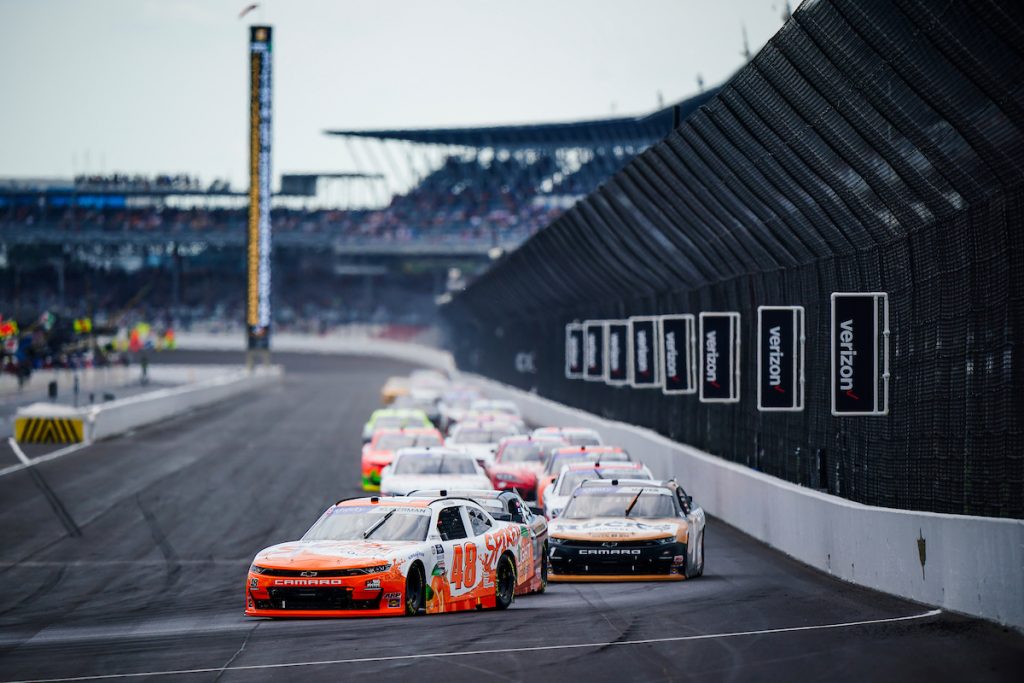
The inaugural Brickyard 400 was finally announced on April 14, 1993 by Speedway President Tony George and NASCAR President Bill France Jr. The Indiana Phone Company reported that the Speedway ticket office received 70,000 incoming calls in the first five minutes that they were open on April 15, 1993. Indianapolis Motor Speedway eventually resorted to a lottery system for tickets after reportedly receiving over 1.9 million ticket requests. No general admission tickets were sold for the race as speedway officials did not want the Indy 500 to lose its title of being the largest spectator event in the world.
A final test was held on August 16-17, 1993 with thirty-five Winston Cup teams participating. Local news reported at the time that 100,000 spectators were in attendance for the test. When race day finally arrived on August 4, 1994 the largest crowd in NASCAR history turned out to see Jeff Gordon win the largest purse (to date) in NASCAR’s history. 350,000 spectators witnessed as local sprint car star turned stock car ace took home $613,000 from a $3.2m purse ($1,292,545 and $6,747,382 respectively in 2024).
A crown jewel was born instantly. The eight highest-attended races in NASCAR history were all Brickyard 400’s. Eighth on the list was the infamous 2008 Brickyard 400 which featured a crowd of 240,000. Unbeknownst at the time, when Jimmie Johnson took the checkered flag on July 27, 2008, he was also taking the checkered flag on the glory days of the Brickyard 400.
Before we can understand the events of 2008, we must first wind the clock back to April of 2002. As we’ve discussed in previous pieces, when asphalt ages and settles it develops subtle bumps and surface irregularities. While this might be acceptable in many racing series, for an open-wheel car traveling at over 240mph (390kmh) it is both unsafe and unacceptable. Prior to the 2002 running of the Indy 500, the entire surface of the speedway was treated with a process called diamond grinding in order to smooth out the racetrack. This process may have removed the bumps, but it also made the surface much more abrasive which provided increased traction.
When the speedway was fully repaved in August of 2004, the result was a buttery smooth racing surface, but it felt slick to drivers and teams who had become accustomed to the traction provided by the abrasive asphalt. In an effort to increase traction on the new asphalt, Indianapolis Motor Speedway hired Penhall Corp to come in and diamond grind the new surface over the winter. What resulted was a high grip, high tire wear racing surface.
The 2008 Brickyard 400 was the first time that NASCAR’s Car of Tomorrow (CoT) was raced around the speedway and it was an unmitigated disaster. The Cot featured a front splitter and a rear wing, which generated more downforce than the previous Gen 4 car. Apex speeds for the Gen 4 car were in the mid-to-high 140mph range and the CoT was able to negotiate the corners around 5mph faster. While the two generations of cars weighed the same, the Cot was taller and had a higher center of gravity. Drivers described the car as feeling top heavy and being more rolled over in the corners than the previous car had been which changes the way that the tires are loaded.
NASCAR decided not to schedule an open test for teams leading into that year’s Brickyard 400 and Goodyear only conducted one tire test with two drivers, Kurt Busch and Dale Earnhardt Jr. This proved to be a grave mistake.
Back in those days, a race weekend featured significantly more practice than the current format with two sessions on Friday and two more on Saturday. Tire wear was higher than expected on Friday, but there wasn’t much panic. Everyone knew that the speedway takes a while to take rubber, surely it would be fine tomorrow. The panic did however begin to set in when tire wear did not get any better during the Saturday practice sessions. The rubber wasn’t meshing with the racetrack, it was instead turning to dust.
NASCAR made the decision to throw a competition caution every 10 to 12 laps to allow teams to change tires. Goodyear went as far as to bring in a trailer full of tires they had prepared for Pocono Raceway to ensure that there were enough tires to finish the event. Even after that short of a run, tires were still failing or wearing down to the cords. The 160-lap race featured 11 caution flags with an average green flag run of only 9 laps.
Goodyear conducted seven tire tests before the following year’s race which went off without an issue. Unfortunately, a bitter taste was still left in fan’s mouths. Only 180,000 turned out for the 2009 race. In 2010 it dropped again to 140,000. By 2017 only 35,000 fans were in attendance to witness Kasey Kahne’s final Cup series win. It almost didn’t feel like the same racetrack.
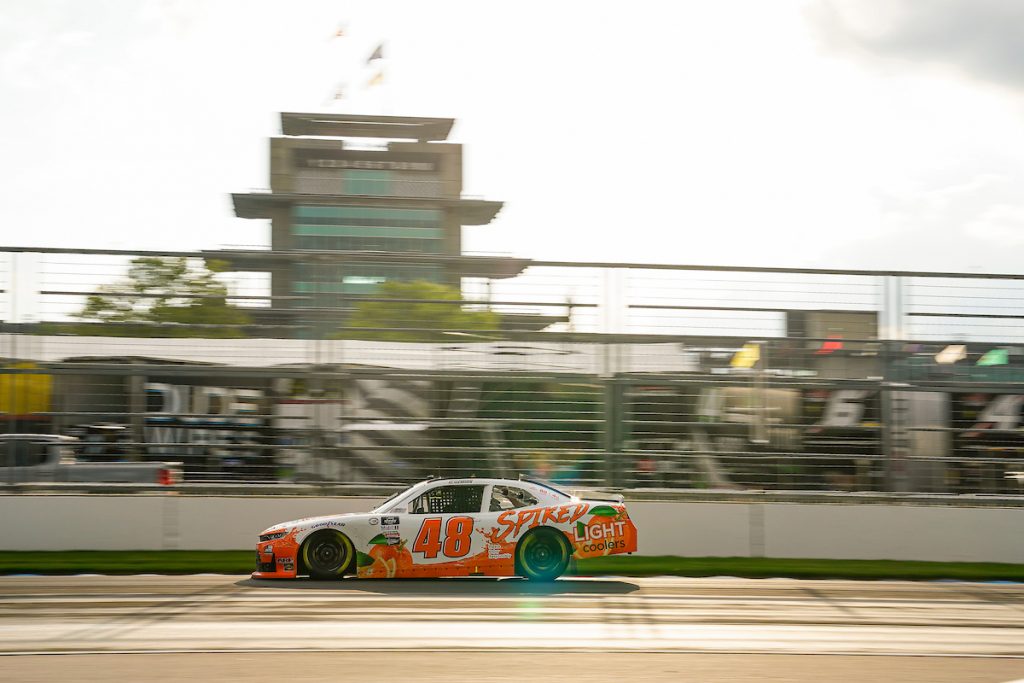
For the 2018 season, NASCAR moved the Brickyard 400 date to become the regular season finale, hoping that playoff drama would help boost ticket sales. Unfortunately, this also moved the race right into the beginning of football season. When Brad Keselowski won car owner Roger Penske’s first Brickyard 400, he did so at an almost empty racetrack. The 2019 running of the Brickyard 400 suffered the same fate.
After the 2020 season, NASCAR moved the race off of the oval and onto the infield road course. While the racing proved to be more entertaining than the last several renditions on the oval, it simply wasn’t the same. The crown had lost its jewel.
That all changes this year. The Brickyard 400 is officially back on the oval. The Next Gen Cup series car has proven to be a shot in the arm on bigger, more aero-dependent tracks and it stands to reason that this race will be much more compelling than when we last were on the oval. The Xfinity series will be utilizing a drafting package this weekend, more on both of these later.
From the sky, Indianapolis Motor Speedway looks like a fairly straightforward 2.5-mile (4 km) rectangle. It features four corners of equal radius and banking, two equal length main straightaways heading south and north and two equal length short chutes heading west and east. The corners are banked at 9* the main straights are 5/8 mile (1 km) and the short chutes are 1/8 mile (0.2 km). Despite its symmetry, all four corners behave completely differently to one another, and there are a number of reasons for this.The front straightaway at Indianapolis features seating on both sides of the circuit and a large grandstand on the outside of Turn 1.
One week from today, cars on track ❤️
RT if you can't wait for the #Indy500 Open Test April 20-21.
The Turn 2 viewing mounds in front of the @IMSMuseum will be open!#INDYCAR | #IsItMayYet? pic.twitter.com/JAC1Gn8tST
— Indianapolis Motor Speedway (@IMS) April 13, 2023
This seating arrangement makes the front straightaway feel like a driver is flying through a canyon, but it also affects the racing. As the sun moves west across the sky it falls behind the Turn 1 grandstands which begin to cast a shadow over this corner as the race progresses.
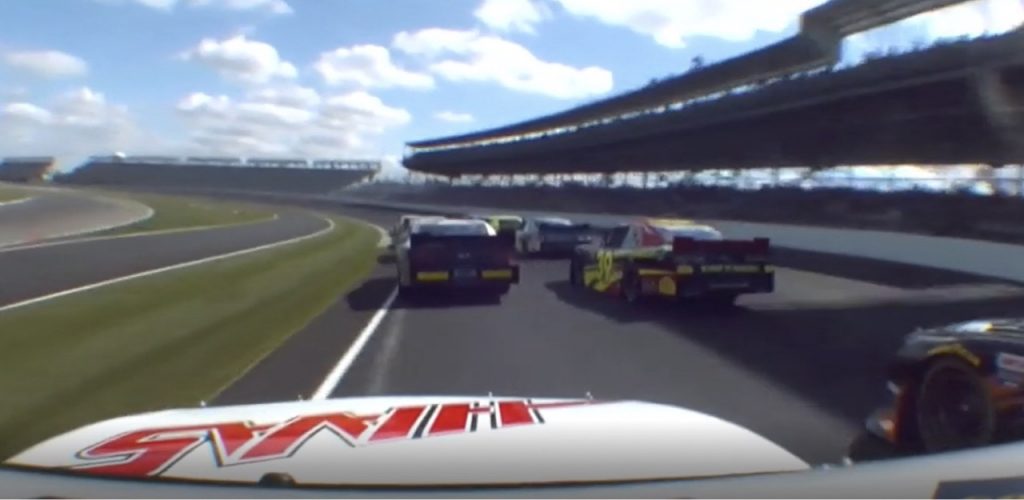
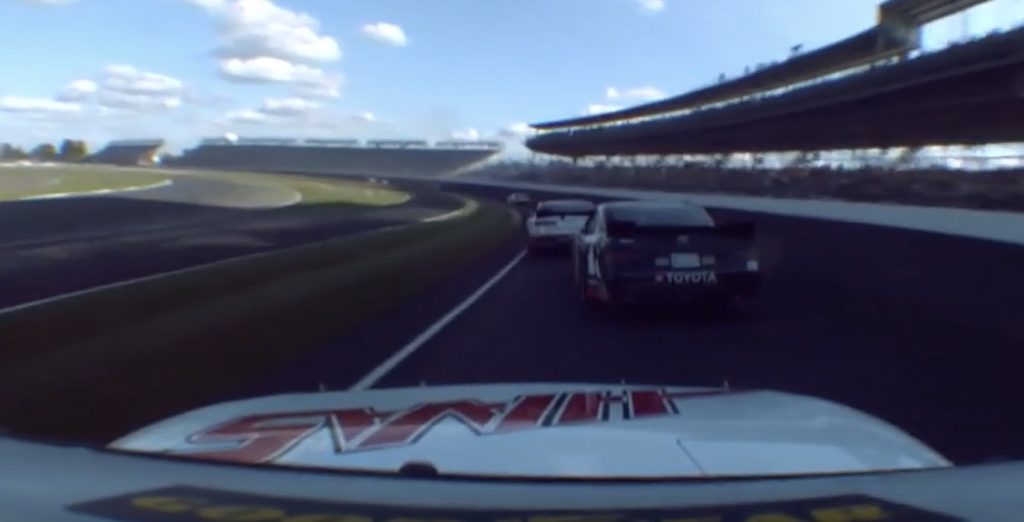
While the shadows grow in Turn 1, the northern end of the track, consisting of Turns 3 and 4, will have been baking in the mid-afternoon sun all day. What this does is create a massive variation in track temperature from one end of the circuit to another. Turn 1 will be the coolest point on the circuit and Turn 3 will be the warmest which causes a shift in car balance and grip level. For more on how track temperature affects race cars, you can check out my piece on Charlotte Motor Speedway.
The seating arrangements at Indianapolis Motor Speedway also play a crucial role in shaping how wind affects the racecars. From the wind rose for Speedway, IN you can see that the prevailing winds come in from the southwest and blow towards the northeast.
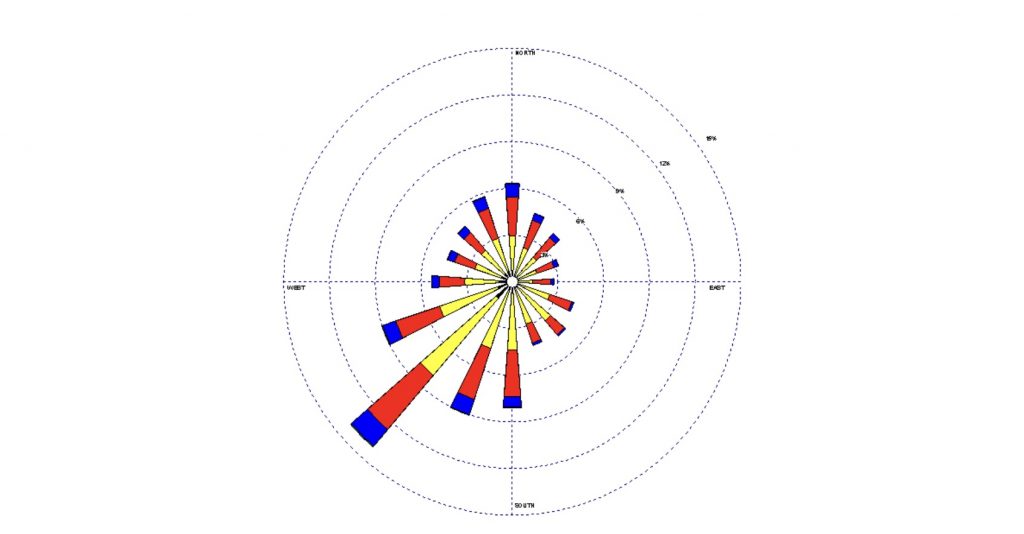
Looking down over the speedway, you can see that Turn 1 is protected from most of the wind by grandstands. This shielding begins to go away on the short chute between Turns 1 and 2 and disappears completely by the exit of Turn 2.
Zooming in on this image, we can see that the Turn 2 grandstands are smaller than those in Turn 1 but also have slight gaps between them.
Essentially, on a typical day the racecar will pick up a crosswind on the short chute that transitions to a tailwind through Turn 2 and down the backstretch. As the relative air speed decreases exiting the corner, so will downforce. The crosswind can unsettle the car on entry to Turn 2 and the tailwind will reduce downforce on exit as well as create slight understeer. The tail wind typically carries all the way down the back straightaway causing drivers to enter Turn 3 at a higher speed than they did Turn 1. Turn 3 will already have less grip than Turn 1 due to the higher surface temperature, and then drivers will have to transition from a tailwind to a crosswind. When a crosswind hits the left side of a car going around an oval it will cause the car to oversteer.
Take a ride onboard with Kyle Larson during qualifying for the 2024 Indy 500 and pay attention to the structures surrounding the racetrack.
Drivers will often describe the entrance to Turn 1 as feeling completely different from that of Turn 3. As you saw from Larson’s onboard, the apex of Turn 1 can’t be sighted until just after the turn-in point due to the infield grandstands and pit lane. The entrance to Turn 3 is wide open on the inside giving drivers a clear sight line into the corner. Even with a slightly lower entry speed, Turn 1 feels more like diving off a cliff than driving into a corner. Parker Kligerman does a good job explaining here why Turn 1 at Indianapolis may just be the greatest corner in racing.
There are two different kinds of racecar that a driver can have at Indianapolis; one that will run fast by itself and one that will race well. We discussed the differences in high and low downforce last week before heading to Pocono Raceway so let’s talk about car balance for a moment. Because the corners are so flat in Indianapolis, drivers must take a huge arc on entry to open up the radius of their corner as much as possible. A large entry arc tends to make a car oversteer, so in order to cut a fast lap on this line a significant amount of security needs to be built into the car’s setup to bring its balance closer to neutral. This is fine and dandy when trying to go fast by yourself, but it will not be conducive to racing. Indianapolis Motor Speedway is essentially a one-lane circuit. Side by side racing is practically impossible, so passing becomes much more of a chess match than at traditional ovals.
A typical pass at Indianapolis takes almost a full lap to complete. Let’s break down a hypothetical pass on entry to Turn 3. On the lap prior to the pass, the two drivers will come down the back straightaway separated by two to three car lengths. The overtaking driver will try to have a better Turns 3 and 4 than the defending driver to build momentum down the front straightaway. Ideally, they would be about one car length behind and closing when they enter Turn 1. The overtaking driver’s goal will be to catch the defending car just past the apex of Turn 2 and be able to exit lower than them. At this point they should be able to pack air on the left rear of the defending car, causing oversteer on exit, and pull alongside them down the back straightaway before entering Turn 3 on the preferred line.
To accomplish this, they will need to be able to both enter and exit the corner lower than the defending car. By taking a shallower line they will keep the left front of their car in cleaner air, allowing them to have more downforce than if they followed in the tire tracks of the defending car. The problem with taking a shallow line when following is that it causes the car to understeer due to both the tighter radius and the reduced downforce. A car that is set up to race well will likely have significant oversteer when driving on the traditional line and more of a balanced feel when running in traffic or on a shallower line. The key for teams is to find a balance between the two. In a perfect world, the car would have a slight oversteer on the traditional line and a slight understeer on the overtaking line.
You can see in this clip as Justin Allgaier executes this passing technique perfectly to take the lead from Kyle Busch during the 2019 Xfinity series race. He approaches Turn 1 closing with momentum, enters and exits lower than Busch, and then tucks underneath Busch on the exit of Turn 2, completing the pass down the back straightaway. You can also see from the aerial shot that Kyle Busch immediately jumps back onto the shallow offensive line as he enters Turn 2 from second position and Justin Allgaier takes a wider line as the leader.
Let’s talk about packages. The last three times that the Xfinity cars visited Indianapolis Motor Speedway, the series utilized a “drafting” package. The package for this racetrack was distinctly different than any other track on the schedule. Cars were fitted with the superspeedway style front splitter which is much larger. The dimensions can be seen below for comparison.
The noses of the cars were fitted with drag ducts on either side. These ducts took air in from the front of the car and directed it out the side of the car ahead of the front tires.
In the rear of the car, the spoiler was also much larger. The standard Xfinity spoiler is 3.5” tall by 60.4” wide (8.9cm x 154cm). For Indianapolis, the spoiler was increased to 6” tall by 64.75” wide (15.2cm x 164.5cm) with additional “dog ear” sections on either edge that were slightly taller.
The net result was cars that punched a gigantic hole in the air and produced incredible amounts of drag. When paired with a restricted engine, drivers were wide open around almost all of the circuit and struggled to get away from each other to any sort of sizeable lead. Because of the car’s massive wake, following drivers were able to generate massive runs which created slingshot-style passes at the end of both main straightaways.
The success of this package in the 2017 Xfinity Series race at Indianapolis inspired NASCAR to try it at both Michigan International Speedway and Pocono Raceway for 2018. After two abysmal races the package was relegated to just Indianapolis in 2019. This package was likely the original inspiration for the Cup series drafting package that was introduced at intermediate tracks for the 2019 season.
When it was first announced that NASCAR was returning to the traditional Brickyard it was hoped that the Xfinity series would run their standard aero and engine package for this race. Unfortunately, that is not the case. The package for this weekend’s Xfinity race is the same one that has been run at Atlanta and will be run in three weeks at Michigan International Speedway. Unlike the previous iteration, this package does not feature any aerodynamic differences on the body of the cars. It’s just a small motor. In my opinion, it’s not optimal to separate out parts of the package. With reduced horsepower, there will be almost no off-throttle time. No braking zones and minimal speed difference from corner entry to apex. Paired with the sleek, low-downforce Xfinity series body, the cars punch a smaller hole in the air so generating a run on the car ahead will be exceptionally difficult. Track position will be key to a successful day and creating any sort of pass will require utmost discipline and precision from the drivers.
Thankfully, the Cup series is running their standard intermediate aero package. Compared to the previous generation of cars, the Next Gen Cup series car has a much narrower aerodynamic wake trailing behind it. At a one-lane racetrack like Indianapolis, this will help improve the quality of racing. The trailing driver should be able to avoid the majority of the leading car’s wake without having to shift their line as much.
Strategy will be a bit interesting this weekend. As we saw last weekend at Pocono Raceway, multiple teams opted to flip the stages and pit under green to gain track position for the next stage. This was the strategy decision that ultimately saw Ryan Blaney prevail over Denny Hamlin in the Cup series race. While Indianapolis and Pocono are both 2.5-mile tracks, the pit lane speed limit in Indianapolis is 10mph slower than at Pocono. The result is a much narrower window for teams to be able to flip stages. Last weekend, drivers had to be within about 13 seconds of the leader to pit and not go a lap down. For Indianapolis, that number will be reduced to about 4 seconds.
Indianapolis Motor Speedway has the narrowest pit lane on the NASCAR calendar. It is not uncommon to see accordion like stack up incidents as drivers try to get in and out of the pit boxes. As always, safety on the pit lane is a priority which is the reason for the reduced pit road speed limit.
It’s anyone’s guess what kind of racing we will see this weekend, but most importantly the crown has regained its jewel. NASCAR is going to the brickyard. We’re in Indiana and we’re back home again.
Photos: Some of these are definitely from the road course race because I don’t have pics of this race, so enjoy!
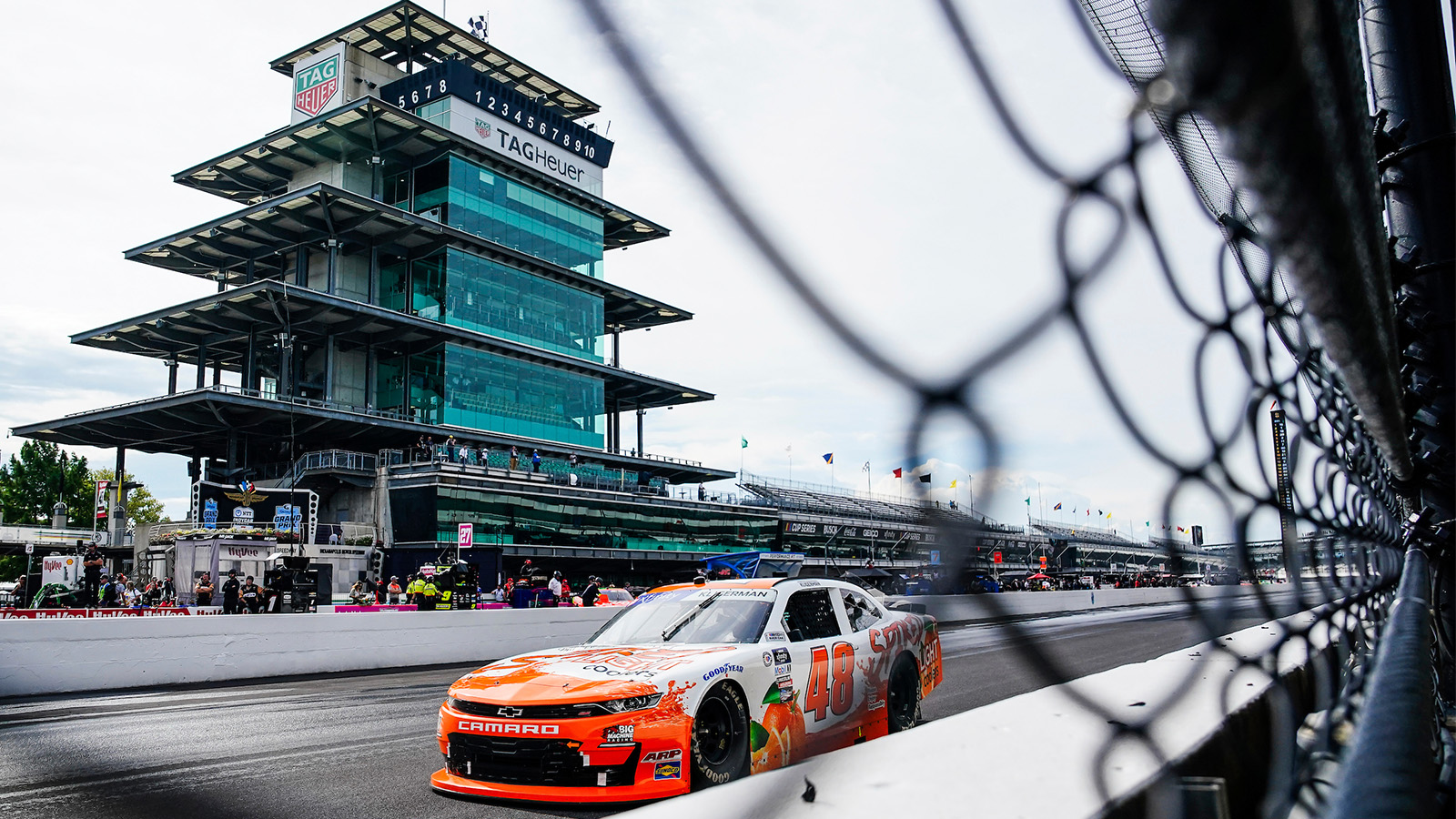




Does Indy not have the same tire woes as the fendered series? Or is it more about the different weight, downforce, tire compounds, etc so that they don’t really compare?
There is something about Indianapolis Motor Speedway. You get chills when you enter the place. I’ve had the fortune to experience it from the driver’s seat, the stands, trackside, and in the control room. It never gets old.
I attended the first Brickyard 400. It was exciting then even though it was the peak of the Jeff Gordon dominance.
Is there any other professional racing series that has driver fistfights after one driver causes a fourth of the field to crash out week after week? It’s the same crowd that enjoys twelve minutes of actual action in a three hour NFL broadcast. And they truly enjoy the constant barrage of advertising. Maybe I don’t drink enough bad beer to make either one interesting.
“ When Brad Keselowski won car owner Roger Penske’s first Brickyard 400, he did so at an almost empty racetrack.”
…. Because the original race date was a rained out…..
Yes true but there was still only 15,000 people there at the checkered. Compared to most other rainouts that’s abysmally low
I was in Indy on Sunday and could not make the Monday race… but no one in town even knew they were having a race that weekend.
For all of you who missed the Xfinity race: Watch the last three laps. One HELL of a finish.
The wreck on Lap 1 was a bit disheartening, but the finish made up for it big time.
One of the best finishes in recent memory for sure
Been watching Cup and Xfinity for many years now, and I really appreciate how you unpack what’s going on and the challenges involved in setting up a car. Also a JRM fan, and it’s cool to read what you’re thinking about up on the pit box. These articles are enlightening, regardless of engagement numbers.
FWIW, I give zero f’s about racing, but these are still fascinating articles that delight my inner geek. Keep ‘em coming!
Nerds unite!
Thanks for your support!
Great article. Over the past few years I’ve enjoyed the Cup cars on road courses more than ovals, but I’m glad to see them back on the oval at Indy.
I think the next gen really flip-flopped which tracks we loved and hated
These are always interesting reads.
Thank you!
Interesting racing facts about the track that I had never heard before. I feel like some pieces of a jigsaw puzzle have been installed in my racing knowledge.
2008 was at the height of the Great Recession. A lot of fans simply didn’t have money to spend on trips when they could watch it on their new HD big screen TVs. Also, the CoTs were, for me anyway, the last nail in the coffin for me watching NASCAR. The win on Sunday, sell in Monday creed died after the Monte Carlo SS and Aero Birds were put to pasture
Happy to fill in the puzzle pieces! And yeah I think it was ultimately a worst possible case scenario. The last race right before the market crashed was a disaster and then the fans never came back.
To be fair, though I feel like the win on Sunday sell on Monday thing was gone early in the 90s. The gen 4 cars (92-06) had basically nothing in common with the street cars and the body shape was clearly not in line with the production variants
Absolutely. That’s why I mentioned that for me, it was the final nail. I think the last race I had a vested interest in who won was Trevor Bain for the Wood Brothers back in 2011.
Just fantastic stuff again!
Thank you!
Mr. McHugh:
I’m really enjoying the technical breakdown of what’s going on here, genuinely.
I gave short track ovals a go in iRacing some time ago and did better than I expected. Truth be told, I never really got a good grasp on exactly how to tune certain basic behaviours into or out of those cars.
Any chance you could write up an article or seven about suspension settings affect cars on short tracks?
I was actually kicking that idea around a bit for the Olympic break
Really appreciate the insight on the tactics and strategy of passing – I always wondered why (esp. in IndyCar) when passing occurred, it was most often very dramatically on the front stretch. I had no idea it that was the denouement of at least a lap-long plan/effort. Thanks for breaking it all down so clearly!
I do have a soft spot for the road course though. I like how it utilizes turn 1 backwards and the straight, kinda like how the Daytona 24 uses a bit of the oval.
Went to see F1 at Indy twice. Had a great time. Got to walk around the infield track during practice and qualifying. Stayed in the same motel as the Minardi team in 2000. Discovered Scotch eggs, saw Polka Boy play. All the Europeans were marveling at how low the prices were. Partied with the Brazilians!
No.
There is absolutely nothing exciting about watching spec cars going round and round an oval ad-nauseam.
Watching mushrooms grow is more interesting.
Look at Formula 1, BTTC and DTM circuits – where drivers make right AND left turns, where track elevations follow the grade of the land, where it may be raining at one end of the course and sunny at the other – and where the cars have some fundamental differences.
That’s interesting.
That’s REAL racing.
I find ovals exciting in part for the “compactness” of the viewing experience – as a spectator, it’s much easier to apprehend most of the action at once, whereas with a road/street course, you’re usually only seeing one small part of it at any given time. At least for me, it provides a more intense sense of the competition.
I also like the iceberg nature of that racing – on the surface, it seems fairly non-complex, but underneath the surface, there’s a ton of it. That’s why I look forward to Adean’s pieces appearing on Saturday so I can get a little more clued in before the weekend’s racing.
Having been in the grandstands at Laguna Seca – where much, but not all, of the road course is visible from the bleachers – it seems to me that one can still get a “compact” view while also watching drivers accelerating, shifting, braking, up and downhill, steering through curves.
At Long Beach, one can wander around and see the race on large screens placed around the venue as one also sees the cars streak by wherever you’re standing/sitting.
To me, this is all rather more interesting than watching drivers just stand on the accelerator and veer left occasionally
(until someone tries to pass, fucks up, and takes out half the field)
The sustained high speeds of ovals are actually a draw for me. On road/street courses, there’s a cadence of fast – slow (that’s great in its own right for sure), but on ovals, esp. the highly banked ones, it’s just really fast – fast.
So the amount of slack (I can’t find the right word here, sorry!) with the inputs and putting it together correctly becomes almost microscopic. That’s totally there with other track configurations, and is what makes racing cool, but the importance of it on a congested oval takes on greater significance.
What makes racing interesting for me is the interactions between all the cars. The slower cars make road racing interesting, when they’re jockeying for position. Formula 1 is often little more than hotlap contests with a little tire endurance spice.
The difference between a fast guy on an oval and a slow guy on an oval is a fraction of a second, and it also means the difference between slightly whiffing a corner and not is potentially dropping out of the draft and losing multiple places, in a car that’s best described as “extremely manual”.
I used to be one of those smirking such-and-suches congratulating myself for my taste in road racing until I tried a handful of oval disciplines in iRacing, and I changed my tune (and my car’s tune) in a hurry. That stuff is genuinely hard. And that’s from the safety of my home office knowing if I stuffed the car I can just go to the kitchen and get myself a drink.
SVG’s struggle with ovals is a testament to how hard they are, however simple it looks. Here’s a guy who’s won road-racing championships struggling to keep up with 18-year-olds, although he did have a good finish yesterday. Maybe Indy (and Pocono) are road-coursey enough that he’s catching on.
iRacing looks like a lot of fun, and I understand plenty of the pros do it even!
I definitely agree with your comment about the slack in inputs. Such a high percentage of the lap is the corner and the margins you’re fighting over are so small. One of my favorite examples of this is Snowball Derby qualifying. I went down to help Erik Jones in 2022 and when it came time to qualify Josh Berry took the pole at a 16.333 and the last car to make the show in speed was Jake Finch in 30th at a 16.622. Last place was 50th place at a 16.915. So for the cars that made the show each position was separated by 0.009 of a second
It’s funny how everyone says it’s just “hit gas, turn left” yet some of the best drivers in the world can’t figure it out…